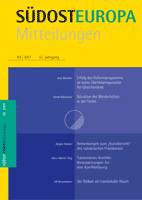Der Transnistrien-Konflikt: Voraussetzungen für eine Konfliktlösung
The Transnistria Conflict: Conditions for Conflict Settlement
Author(s): Hans Martin SiegSubject(s): Politics / Political Sciences
Published by: Südosteuropa Gesellschaft e.V.
Summary/Abstract: With the dissolution of the Soviet Union and the Republic of Moldova gaining independence the Transnistrian region of the country broke away under a separatist regime in Tiraspol from the central government in Chisinau in 1990. Since then two different political systems have emerged in both parts of Moldova with a more authoritarian government in Tiraspol leaning towards Russia and a more democratic system in Chisinau striving for European integration. To reach a settlement of the conflict caused by the secession of Transnistria an international framework of negotiations was established known as the “5+2” format (Chisinau, Tiraspol, Russia, Ukraine and the OSCE as well as the EU and the US as observers). However, until today all proposals for a resolution of the Transnistria conflict failed to find the consent of either Chisinau or Tiraspol. In 2006 formal “5+2 negotiations” ceased to continue. In their Meseberg Memorandum in June 2010 Chancellor Merkel and President Medvedev agreed to propose a new common effort of Russia and the EU to find a solution for the Transnistria conflict. Thus it has become a potential test case for EU-Russian cooperation and the international framework for a viable settlement of the Transnistria conflict has improved considerably. As one consequence, formal “5+2 negotiations” are likely to be resumed soon. Nevertheless, given the differences between the political systems on the two banks of the Dniester, the requirements for a successful reunification of the Republic of Moldova have yet to be met on the national level.
Journal: Südosteuropa Mitteilungen
- Issue Year: 2011
- Issue No: 03
- Page Range: 62-77
- Page Count: 16
- Language: German
- Content File-PDF

